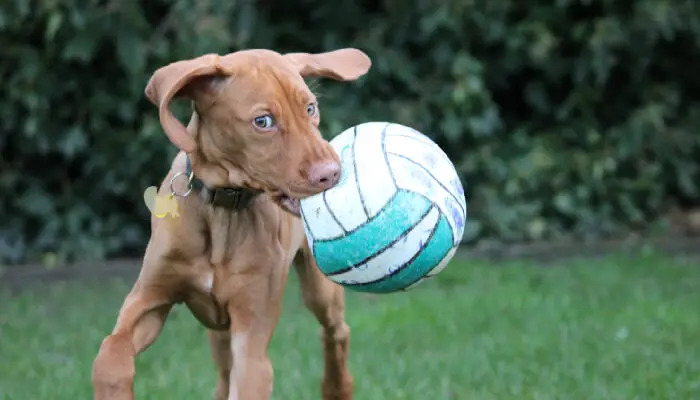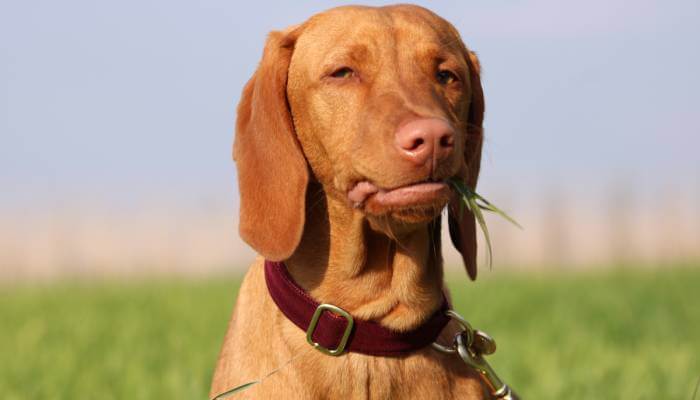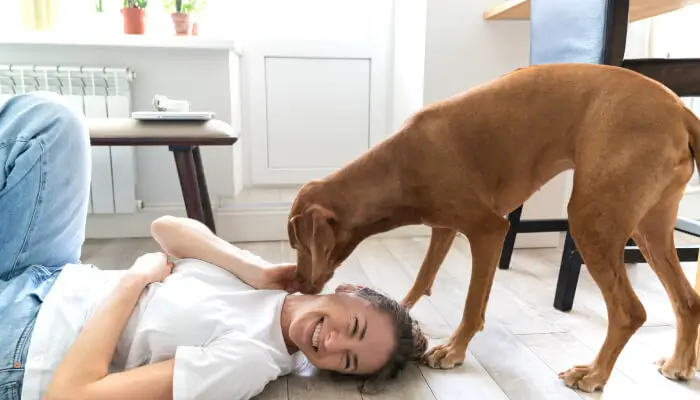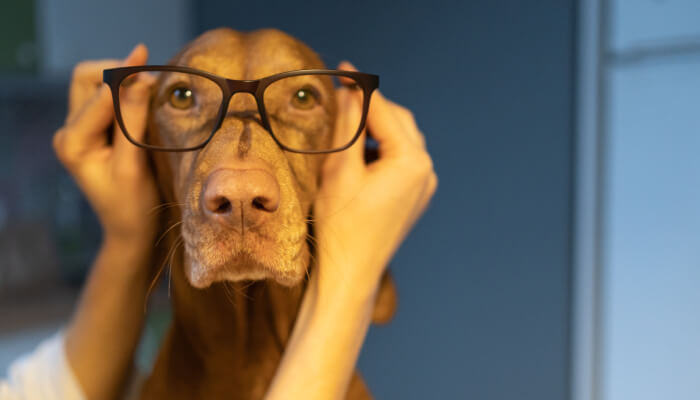Once you bring a Vizsla home, it becomes your family. The love, care, and attention that you give your dog draw them closer to you. So, it is not uncommon for Vizsla to feel attached to you or any family members. But the real question is that will Vizslas have separation anxiety in your absence?
Anxiety is a usual term for humans, but dogs like Vizslas also have separation anxiety. There are several causes of this problem: lack of care, improper diet, inadequate exercise, abuse, mistreatment, previous attacks or accidents, or loss of a family member or newer surroundings.
Separation Anxiety can be an upsetting and frustrating experience for both pet owners and their furry friends. Thankfully, there are many ways that you can help your dog overcome separation anxiety! We will explore the topic in depth below, so keep reading!
Do Vizslas Have Separation Anxiety?
It’s natural for dogs to exhibit signs of separation anxiety when their owners leave them alone. It can be especially true with Vizslas, which are incredibly loyal to those they love. However, just because your dog may exhibit some behavior that looks like separation anxiety doesn’t mean he is, in fact suffering from it.
Are Vizslas Prone To Separation Anxiety?
Vizsla dogs are natural companions and enjoy the company of their owners. Usually, this quality makes them prone to suffering from separation anxiety, which can be detrimental for both dog and owner.
Vizslas love their owners and bond well with the people around them. Further, they are also fond of people and enjoy the company. These dogs are such social pets that they can live peacefully in a household with kids, other pets, and elders.
Since Vizslas get familiar with the members and devote themselves to the house, they are more likely to suffer from separation anxiety in the absence of people or company.
How Do I Know That My Vizsla Dog Is Suffering From Separation Anxiety?
The most important thing to look for is how your pet responds and behaves when you leave him alone by himself.
Compulsive And Destructive Behavior
If your dog is experiencing separation anxiety, he will likely show some compulsive and destructive behavior while you are not in the house.
It can include chewing, digging, or eating inappropriate things like sofas, curtains, etc.
Aggression In Vizsla Dogs
If your Vizsla Dog is experiencing separation anxiety, he will also be more likely to show aggression.
He might bark or growl at you if you try and leave him alone. Usually, this is a severe sign that there’s an issue.
Unhygienic Habits
If your Vizsla Dog has separation anxiety, then he will also be more likely to develop unhygienic habits in your absence. For example, they will start to chew everything close to them, dig the soil, and destroy the furniture, curtains, and carpets by peeing on them. This behavior might also include house soiling, chewing on feces, and vomiting too.
Frequent Barks From Vizsla For No Reason At All
If your Vizsla Dog has separation anxiety, then he will also be more likely to bark from time to time for no reason at all.
It is a sign that something might not be correct. It’s worth looking into if this behavior continues after you’ve taken any precautions, such as de-cluttering or cleaning up the yard, etc.
Running Away From Home
If your Vizsla Dog has separation anxiety, then he will be more likely to run away from home when you are not around them.
It is a severe sign and can result in road accidents like hitting a car or not finding their way back home. So it’s worth taking precautions such as installing an invisible dog fence before this behavior happens.
Some Vizslas will feel more comfortable if they have a safe place to go when they are away.
Suppose your Vizsla is exhibiting signs of separation anxiety. In that case, he may benefit from having his own space in the form of an indoor kennel or dog pen where he can find comfort and familiarity during these difficult times.
How Can I Prevent My Vizsla Dog From Suffering From Separation Anxiety?
You can help your Vizsla dog to feel less aggressive or anxious when you leave him alone. Just make sure that the time spent apart is as short and sweet as possible.
Exercise Your Vizsla Dog
One of the best things you can do is to get your dog some exercise before he has to spend time by himself.
It will tire him out and make him exhausted. So, Vizslas are more likely to sleep when left alone. Thus, this will help with his anxiety levels.
Body Language
If you are concerned about your Vizsla Dog’s separation anxiety, then it might be worth taking a look at his body language.
A dog in distress will have an anxious and stiff posture, with its head held low.
They may also pant from time to time or freeze up when they don’t know what else to do.
Avoid Delicate Situations
If you are concerned about your Vizsla Dog’s separation anxiety, then it might be worth avoiding delicate situations.
Do not leave him home alone if he has a history of escaping or is likely to chew on inappropriate things like sofas, curtains, etc.
Don’t Leave Your Vizsla Alone For Too Long.
The Vizsla is a dog that needs its owner’s attention. While you can leave your dog alone at home for short periods, the Vizsla will suffer from separation anxiety when left on its own for an extended period. Then, your Vizsla starts excessively barking and whining while you are not around them.
A good rule of thumb is to only leave them alone for a maximum of four hours at one time. And don’t make their abandonment any more complicated than it needs to be by trying to sneak out.
Do Not Bring Them To The Smaller Apartment
The Vizsla is a very active dog and needs plenty of space to move around. Bringing your Vizsla to a smaller apartment will only make it more likely to suffer from separation anxiety when left alone for short periods due to the lack of room.
How Can I Treat My Vizsla Dog’s Separation Anxiety?
It’s not always easy to treat separation anxiety in a dog. It is because of other behavioral issues like barking and house soiling associated with this anxiety.
If you think that your Vizsla dog is suffering from separation anxiety, then it’s crucial to know what type of behavior he displays.
Is there something wrong with his general health, for example? Does he have any allergies or other medical conditions?
If you can rule these out, then training and behavior modification is the best way to help him.
One common technique for managing separation anxiety in Vizsla dogs is counter conditioning. This condition involves pairing up a stimulus that your dog finds stressful, such as when you leave them alone, with something they enjoy, like food or play.
It can help them to stop associating the stressful stimulus with something that they enjoy so much.
How Long Can I Leave My Vizsla Alone?
It would be best if you never left your Vizsla dog alone for more than a couple of hours, especially if he’s still young or doesn’t have many opportunities to be on his own.
The best course of action is to take a break from work. Bring your Vizsla dog into the office with you for an hour or two if they’re having trouble coping on their own.
Vizslas are energetic, loyal family dogs that love spending time in groups. However, they usually have separation anxiety, but there are ways to help them.
Conclusion
In conclusion, Vizslas are an intelligent breed of dog popular for their energy and affectionate nature. They are family dogs, fiercely loyal to the people they love. However, they have a strong sense of being pack animals, so they need companionship most of the day or suffer from separation anxiety. Therefore, it can be frustrating for owners who need to leave the house for long periods, such as at work.
So, I hope this blog can help owners calm their dogs and give them some ideas about Vizsla’s proper care.
Keeping Vizslas is not tricky; be attentive to their diet, exercise, grooming, and health issues.



